Interventions on Nick Srnicek’s “Platform Capitalism”
A representation of the current platform capitalist culture.
These visualisations give an overview of the platform economy, identified as a type of business model and a digital infrastructure that contains intermediaries such as Cloud platforms, Advertising platforms, Lean platforms, Industrial platforms and Product platforms. These are all reliant on “network effects” (Srnicek, 45); the more numerous users who use the platform, the more valuable the platform will become.
To be successful, platforms make use of “cross-subsidisation” (Srnicek, 46) meaning that a company makes use of two of its arms. One offers free or low-cost services, and the other provides a service with raised prices to make up for the losses of the other one (e.g. Google’s free e-mail service and its paid ad service). Platforms also embody a form of politics (Srnicek, 47) meaning that each platform has its own rules of products or services. These platforms do not only gain access to data produced by users, but also control and govern the rules of their platform culture.
Here you can find main characteristics and illustrations based on the five platform types identified by Srnicek, with a vaporwave theme.
Cloud platforms
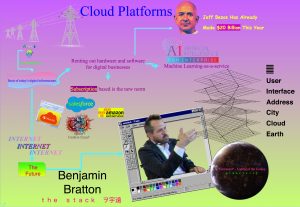
Cloud platforms by Jasper van Tilburg, Els Versluis, Vera Seegers, Nadine Werner and Ståle Grut (2018). Click image for full resolution.
The corporate cloud rental started with e-commerce in 1999. The web service company Amazon is the most significant employer in the digital economy, followed by Google, Microsoft and IBM. Cloud platforms provide on-demand service as servers, storage and computing power, software development tools, operating tools and ready-made applications (Srnicek, 61). They enable outsourcing of a company’s information technology department (data analysis, storage of customer information, maintenance of company’s servers).
The way that they extract data is closely tied to a rental model. Cloud platforms build the basic infrastructure that the digital economy relies on. This enables them to rent out tools for profit making to others, while also collecting data for their own use (Srnicek, 64).
Advertising platforms
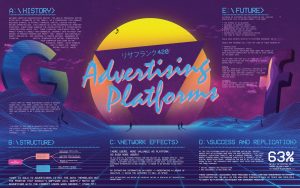
Advertising platforms summary by Kenan Abdulghani, Esmee Schoutens, Liam Corcoran, Anne Kervers and Renate Brulleman (2018). Click image for full resolution.
It emerged from the dot-com bust in 2000. Google was the first company to turn advertising into their primary revenue source. Facebook has been in its trails proving the process replicable. Via Google’s software AdWords, extracted data moved from a tool to improve services to becoming a way to collect advertising revenue.
With Web 2.0 shifting to user-generated data, which critical theorists of the web would call ‘free labour’. They accuse Facebook and Google of selling data/free labour. However, all social interactions become free labour in capitalism. The emerging trend in this space is surveillance capitalism (Srnicek, 57). A convergence of surveillance and profit making in the digital economy. Data extraction has become a critical method of building a monopolistic platform.
Lean platforms

Lean platforms by J.P. de Magalhães Guarnieri, Anna Lezard, Ayşe Tosum, Nicole Leeflang and Yarden Skop (2018). Click image for full resolution.
As a reaction to retrogression of companies in the early internet economy in 1990, Lean platforms returned to a ‘growth-before-profit’ business model. Previous platforms’ business models aimed to gain profit over time. They range from specialised firms for a variety of services (cleaning, shopping etc.) to more general marketplaces like TaskRabbit and Mechanical Turk.
It is a multi-sided platform where users, customers, employers and workers can meet each other. Connected to lean platforms are asset-less companies and virtual companies; however, they do own an essential core asset: the software and data analytics.
Industry platforms
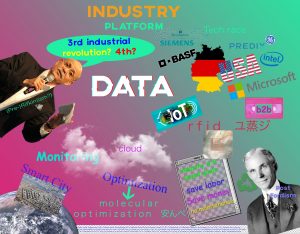
Industry platforms: Jasper van Tilburg, Els Versluis, Vera Seegers, Nadine Werner and Ståle Grut (2018). Click image for full resolution.
These is closely tied to the ‘The Internet of Things’ (IoT) on the B2B market. They are essentially embedding sensors and computer chips into the industrial production process and trackers into the logistic process. Germany calls it ‘Industry 4.0’. Here everything in the production process is connected via the internet, from machines to managers to components; “material goods become inseparable from their informational representations” (Srnicek, 65).
Network effects are essential to solidifying a monopoly position which stimulates expressions of national economic competition (e.g. Germany & US – a link to Marxist critique).
Product platforms

Product platforms by Mick Vierbergen, David Molloy, Ilja van de Rhoer, Veders, Sara Vuorio and Leon Smits (2018). Click image for full resolution.
IoT and cloud computing have enabled an ‘on-demand platform’; a combination of product- and lean platforms. These platforms embody a goods-as-service business model, wherein raw data is collected from sensors. To manage an airplane engine, one could make use of weather data, air-traffic control information and engine performance).
This data, analysed and validated via feedback-loops, is their key economic asset. These assets are owned by the companies and could be rented out. This situates Rolls Royce for example as the main monopolist in its sector.
The future
According to Srnicek, the spread of Adblockers and the dependence on broader economic health and household wealth, suggest advertising platforms are prone to disappear or change to a pay-per-view/rentist business model. The same goes for the exploitative business model of lean platforms since they will need new sources to become profitable and viable. As cloud platforms are on the rise, an Amazonian-Internet is a possible future.
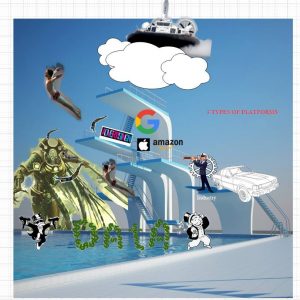
The platform capitalist future by Tsjip van der Nat
Slides
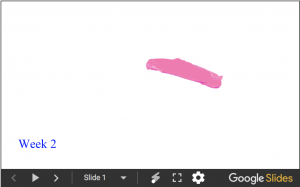
Slides from the class found here.
Bibliography
Srnicek, Nick. Platform Capitalism. Wiley, 2016.